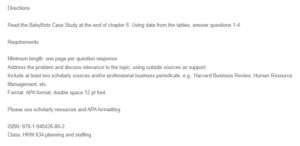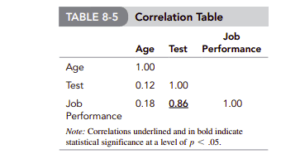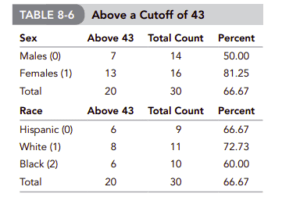BabyBots Case Study
BabyBots case presents a relevant challenge for human resource managers whereby the head of staff is required to help the company validate the manual dexterity test. Surprisingly, the robot manufacturing company has never validated the dexterity test used to assess the candidates in the selection process for its manufacturing jobs (Phillips & Gully, 2015). Therefore, a concurrent validation study is conducted whereby the test is administered to 30 workers in the manufacturing department. The study conducts the correlation test between age, the manual dexterity test score, and job performance to assess the validity of the test. A relationship between the employees’ test scores and performance ratings is also examined to answer the following questions.
-
The kind of relationship that exists between employees’ scores on the manual dexterity test and their performance ratings
Figure 1: Correlation Matrix for Age, Dexterity Test Score, and Job Performance
Correlation was performed to test whether there is a relationship and the nature of the relationship between dexterity test scores and job performance. The correlation between job performance and dexterity test scores provides crucial information about the effectiveness and competence of the candidates in performing skilled work (Perera & Kaluarachchige, 2020). BabyBots Company will require highly skilled workers to manufacture and market its products efficiently. From the analysis of the correlation between dexterity test and job performance, the correlation coefficient is 0.86. This indicates that there is a strong positive relationship between employees’ scores on manual dexterity test and their job performance. Consequently, this implies that employees who return high dexterity test scores will perform better compared to employees with lower dexterity test scores, similar to the study by Perera and Kaluarachchige (2020). The correlation coefficient is also significant at p<.05.
Age is also included in the correlation since an employee’s job performance may be influenced by their age. However, age has a small positive correlation with job performance, which indicates that the effect of an employee’s age on job performance is minimal. The correlation coefficient for age and job performance is also insignificant at p<.05. This implies that to use multiple variables to predict job performance, it might be necessary to use variables that will yield stronger positive or negative correlation values with job performance. A positive correlation tending to 1 shows a stronger positive influence on job performance, while a negative correlation tending to -1 will imply a strong negative impact on job performance (Stangor, 2015).
-
Supposing a candidate scored 44 on the manual dexterity test and the regression equation predicting job performance using the manual dexterity test is 32.465 + 1.234 * Manual dexterity test score2. The candidate’s predicted job performance would be;
The regression equation can be used to predict the response variable using the values of the explanatory variables. In this case, the response variable is job performance, while the explanatory variable will be the manual dexterity test score. To obtain the predicted job performance score for a candidate who scored 44 on the manual dexterity test score, we can substitute the score value in the model Y= a + bX;
Y= 32.465 + 11.234 (Manual dexterity test score)
where; Y= Job Performance
32.465= a b=1.234
Y= 32.465 + 1.234(44) = 86.761
-
Assuming that only candidates with predicted performance above 85 are to be hired. This translates to a score of at least 43 on the manual dexterity test. Assume only those with scores above 43 were hired (20 of the 30 people in this sample). Would the use of this test have led to evidence of adverse impact based on sex or race? The relevant data on the 20 people exceeding the cut-off were presented earlier in the table.
Figure 2: Proportions of Race and Gender Selected due to the Cut-off Mark
The table above shows the proportion of candidates who would qualify to be hired based on the dexterity score of at least 43. Although the dexterity score has nothing to do with race and gender, the table indicates that the recruitment will disproportionately favor some races and genders more than others. For instance, the cut-off would mean that a larger proportion of females (81.25%) would be hired from the female candidate contestants compared to 50% of the male candidates. This implies that among the total number of hired employees, 65% would be females, while 35% would be males.
Based on racial identity, the cut-off point would also imply that people from different races are hired disproportionately. Among the total candidates by race who participated in the selection process, 66.67%, 72.73%, and 60.00% were the proportions of Hispanic, White, and Black people selected. The number of people selected for each race in relation to the total number of employees selected implies that out of the selected candidates, 30%, 40%, and 30% represent Hispanic, White, and Black people, respectively. This indicates a small variation in the proportions based on the race of the selected employees. Although the cut-off mark of 43 did not target any gender or race, it may have an adverse impact on the proportions of selected people based on race and gender.
-
Given the validity results you found, would you recommend use of this test as a selection device? If so, how would you use it?
To determine whether the test is appropriate for use as a selection tool, it is important to consider the strength and direction of the correlation between the explanatory and the response variable. In this case, the dexterity test score has a significant and positive correlation with the job performance of employees. This indicates that it is a valid tool for selecting employees. I would employ the tool in selecting employees while taking keen note on offering equal opportunities for different races and gender, since they are the confounding variables that may affect the selection process.
References
Phillips, J. M., & Gully, S. M. (2015). Strategic Staffing. (3rd Edition) Edinburgh Gate: Pearson Education Limited.
Perera, N., & Kaluarachchige, I. (2020). Dexterity Tests Scores and Employee Performance of Sewing Machine Operators. https://www.researchgate.net/publication/341203798_DEXTERITY_TESTS_SCORES_AND_EMPLOYEE_PERFORMANCE_OF_SEWING_MACHINE_OPERATORS
Stangor, C. (2015). Research methods for the behavioral sciences (5th ed.). Stamford, CT: Cengage Learning.
ORDER A PLAGIARISM-FREE PAPER HERE
We’ll write everything from scratch
Question

BabyBots Case Study
Directions
Read the BabyBots Case Study at the end of chapter 8. Using data from the tables, answer questions 1-4.
Requirements
Minimum length: one page per question response
Address the problem and discuss relevance to the topic, using outside sources as support.
Include at least two scholarly sources and/or professional business periodicals, e.g., Harvard Business Review, Human Resource Management, etc.
Format: APA format, double space 12 pt font.
Please use scholarly resources and APA formatting.
ISBN: 978-1-948426-86-2
Class: HRM 634 planning and staffing



